
back to House of the Sun index

This article is also available in PDF format.
|
The Baltic Sea Anomaly, as it is commonly called, has gotten a lot of attention in the media in the past years. As it always the case with TV and radio, information about its discovery is also pretty general, and one is inclined to think that it is a misinterpretation of just a curiously shaped rock formation. When I started to look up the real data that was gathered by the diving team, I found that there was a lot of very interesting details. Unfortunately, these were released in bits and pieces. Some of the information appeared on the divers team's website and then disappeared again. Some of the disappeared information did get saved on other websites. The data that the team gathered on their second dive was very intriguing. Every single data by itself is not conclusive, but all together they point into one direction: that the 'anomaly' they discovered is an artificial object. The diver's team can only hint at what it might be, as making an outright statement might discredit them. However I can straightforward say that what the data points to is a very ancient building/factory/metal mining and/or processing facility. I tried to present this complex subject in a clear manner. If you want to know more details click on the links). |

|
An artist rendering based on the data:
|
|
Contents of this page: Electrical Interference Anomalous Anomalous Temperature Readings |
|
The Baltic Sea Anomaly is located at 60.826°N 19.796°E (or 62.0524 N 19.3716 W according to another source) , and was discovered by a Swedish diving group, called Ocean-X Team, of which Dennis Åsberg and Peter Lindberg are the owners and team leaders. The group describes themselves as treasure hunters and salvage operators who specialize in underwater searches for sunken "antique high-end alcoholic beverages and historic artifacts". |
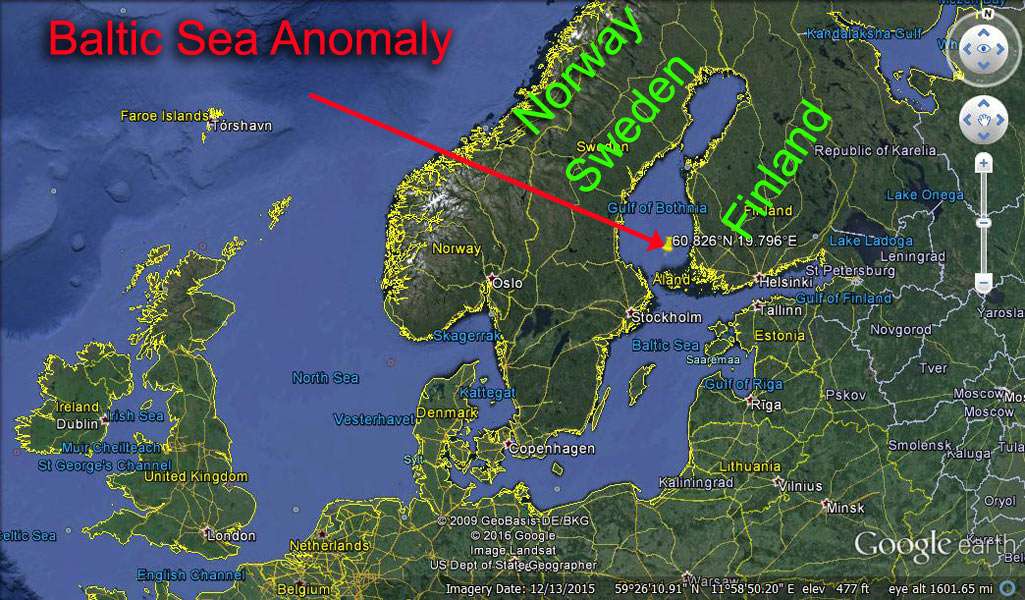
|
In June 2011, looking for shipwrecks, the Swedish Ocean-X diving team discovered a 60 meter (180 feet) diameter circular rock-like formation on the floor (83 meters, or 275 feet, deep) of the northern Baltic Sea, at the center of the Bothnian Sea (between Sweden and Finland). It was an unexpected find, and it was strange enough to ponder if they had found something extraordinary. The sonar picked up something that looked like a circular structure, with a long trail scooped out out of the bottom of the sea leading towards the object. |
|
The original sonar scan. The object is to the right, and the trail scooped out of the seabed goes towards the left. |
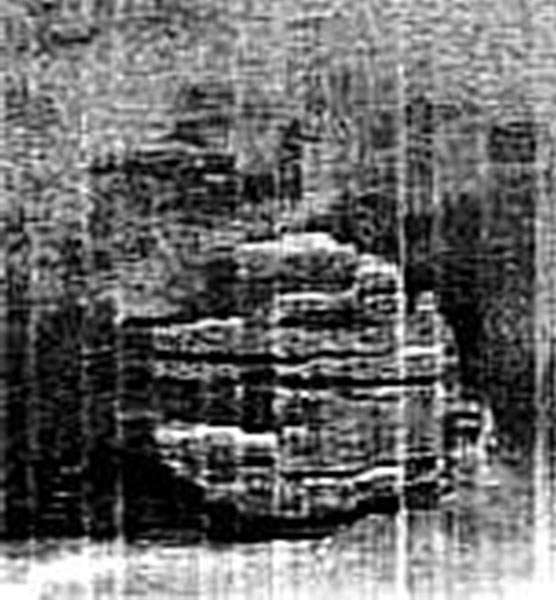 |
|
At this point it is called an 'anomaly' because it should not be there if we only accept orthodox theories of what can and cannot be on the bottom of the ocean. However, there are many indications that it is at least a man-made structure, and that raises a lot of questions about what it might be and why it is there. From in the beginning, scientists and the media have given their widely different opinions of what the anomaly is, based on their own preconceptions without looking at the strange characteristics. At first it looks like it might be a crashed spaceship. |
|
The Ocean-X Team (OXT) returned to the site in 2012. This turned out to be a very interesting event, from more than one perspective. One thing to understand is that their find in 2011 must have come to the attention of the military (of more than one nation). The military (we are using a general term here for certain organizations) have always been interested in ancient civilizations and their advanced technology, or in crashed alien spaceships. After all what military would not want to lay hands on some exotic technology that they can turn into yet another weapon? Ocean-X Team (OXT) was heading out to sea, and wonder-o-wonder, who was showing up? Six large Swedish Navy ships. One of them was heading straight for them, then anchored a distance in front of them, and after a while it left. OXR doesn't realize it that a message had been given. |
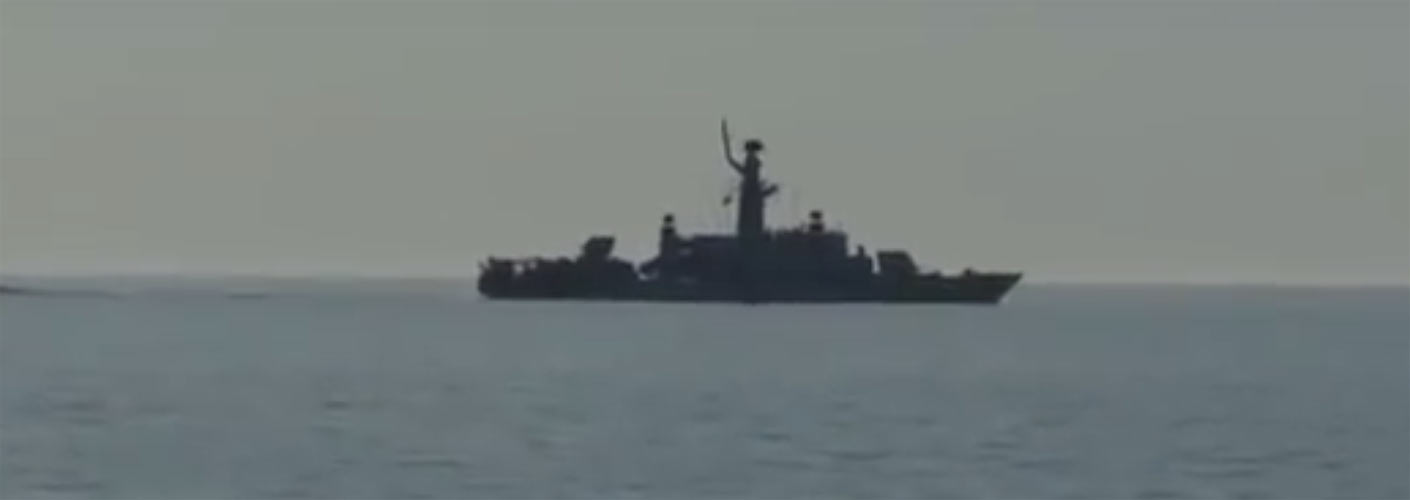
|
When the OXT arrived at the location they still had to scan the ocean floor in order to find the object again, as the coordinates they had from the previous years were not that precise. It took some time, but they finally located it again. They first launched an ROV, a remotely operated underwater vehicle, to gather data and to make sure it was safe for the divers to go down. The sonar also provided close-up images with sonar equipment. The object, which measured 60 meters (197 feet) in diameter, seemed to be made of concrete or cement, and man-made. When the divers went down, they made further observations. Not an easy task considering that visibility at the ocean floor was only about 1 meter (3 feet) with the lights they had with them. At 60 meters (198 feet) it is completely dark. Temperature was about 6 to 7 degrees Celsius. They could only spend 10 minutes at the object because of the great depth. Going back to the surface took 90 minutes, the time necessary to avoid decompression sickness and nitrogen narcosis. One of the divers said that the object seemed to have been molded before it turned into stone. The divers took some samples of some stones for analysis. From all the data they gathered, the whole thing became even more mysterious. Let's have a look at the data. |
|
At first glance, the the whole thing looks like it was made out of cement.
|
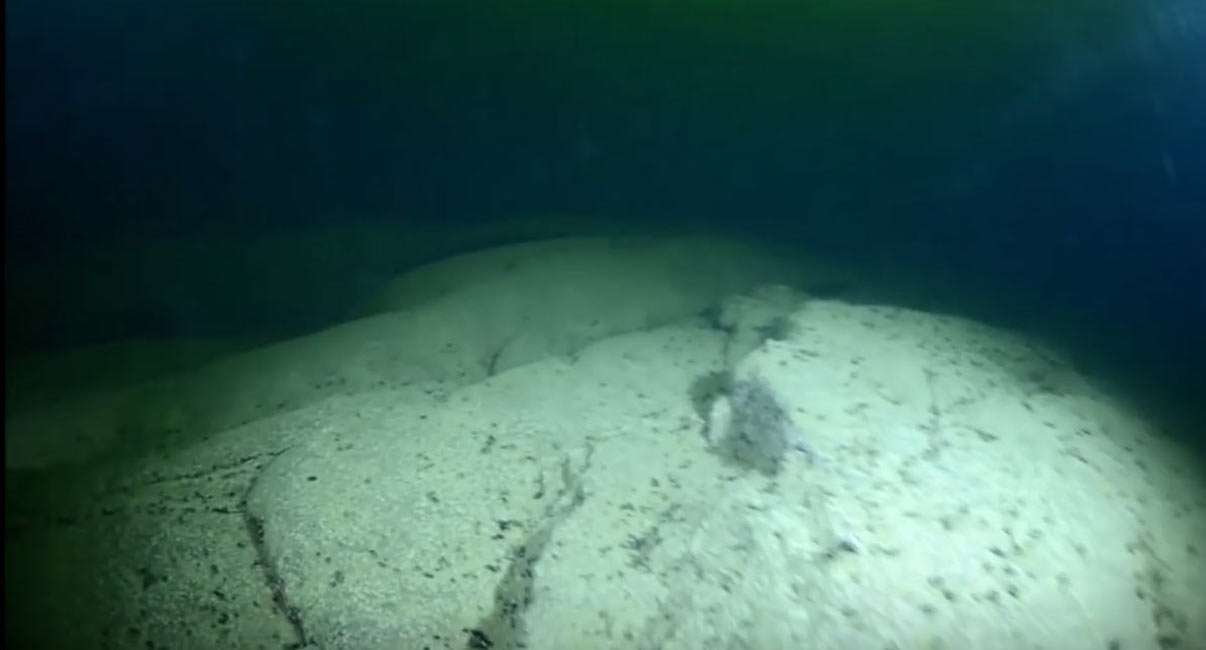 |
|
It became clear that there seemed to be two parts to the structure. The top is round and thick, and lies on top another structure that is rising 3-4 meters/10-13 feet high. Because the top is a little larger the whole thing is compared to a mushroom shape. The lower structure looks to be made from the same material. The original sonar data showed that both the large circular object and the second, smaller one nearby (see below) are made of a hard material. The object itself has a very smooth finish, unlike the rocky surfaces they usually encounter on the bottom of the sea. Therefore their first thought was that it was made from concrete. |
drawing by the OXT:  |
an artist rendering: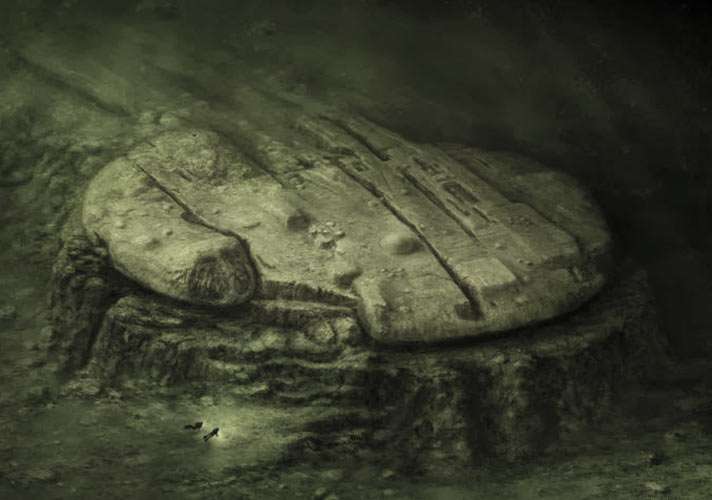 |
|
One of the important details, often not mentioned in the TV interview with OXT is the impression that the stones look burned. One of the divers mentioned: "It looks like a round object separated from the bottom. It looks very, very old. And like concrete. When we brush it off it is black." "It seems like the circle is covered in a very thin layer of sediment, but at certain locations the silt is thicker, nearly like clay. I guess that the currents can stir the silt up at these locations. When the divers scraped it off a blackish surface appeared underneath." "The surface of the circle is not entirely smooth, in some places it is cracking. It appears to be covered in some type of hard cement-like substance, mineral deposit. After being chipped, the interior of object is black." During the dive, the team swam slowly over the top of the object looking down where they encountered some strange sights. Stone circles, like “fireplaces”, of hard black “almost petrified” burnt looking stones, each a few inches in diameter, like 4 or 5 pearls in a necklace in various arrangements on top of the dome. The stones appear to be arranged in definite circular shapes, so there is no possibility of this being done through any natural process of weathering or even glaciation. Stefan Hogeborn, 47, is a veteran of 6000 dives spanning his 20 year career and is one of the expert divers who was completely mesmerized by what he saw. “Normally stones don’t burn,” Hogeborn said. “I can’t explain what we saw, and I went down there to answer questions, but I came up with even more questions,” he added. Peter Lindberg mentioned that “The divers said that a “blackish” powder had been attracted to the camera." and “The surface is cracked, there is a black material that fills the cracks but we are unsure what this material is.” So far it looks that there was an intense fire that raged over the structure, or that the structure itself was generating intense heat. Maybe it was once a metal processing facility, with high heat furnaces. We will come back to the sampled rocks and their analysis later on in this article. The high heat and burn features keeps popping up in the OXT statements. The rocks and surface of the structure does not seem to fit with what is normally found on the seabed in the Baltic Sea. The following statement is very revealing in light of the idea that the building probably once was a mining and/or metal processing facility: "Looks like something has been very hot down there, so that the stone has melted. Dennis believes this to be true because “some stones look like their up side is burned. Also the blackish material which looks like it has been poured out gives the sense that it might been some heat down there.” – Peter Lindberg, July 4, 2012 "The surface of the (circular) object has cracks in it in some places 1-2 inches wide, and in these cracks, it looks like something has poured out like magma…If the magma had come out before the ice age, it should have been scraped away by the ice, but now it’s there like it poured out yesterday." – Earthfiles interview with Peter Lindberg "As you understand it is very much in this that points toward this not being just a "stone formation". “The cracks seams not to be irregular, they seams to go vertically or horizontally. Behind them you can see a blackish colored mineral(?) with the structure of old wooden planks.” – Peter Lindberg, June 21, 2012; Source: Baltic Anomaly Current Facts That last statement caught my attention: a blackish colored mineral(?) with the structure of old wooden planks. Did they see this structured mineral behind the cracks? Or did they discover this mineral when they examined the rocks they gathered from the top of the building. They not only gathered loose rocks, but they also broke pieces off from the structure itself. This could mean they have in their possession pieces broken off from the roof part of the building itself that show this 'old wooden plank' structure of a mineral. In other words, it is a mineral, or metal, that crystallized into such a crystalline structure. Why did the OXT not show us these stones? Or did they? The following pictures are from only one source: a YouTube video of a person who claims "The following photos are a complete mystery to me. They were posted on the Ocean Explorer Facebook page, with no real explanation. Are they pieces from the mysterious circular object that sits on the bottom of the Baltic Sea?" That video was posted on Jan 4, 2013. I had a look at the Ocean Explorer Facebook page, and they are not there (anymore). The pictures do show a crystallized mineral or metal that does have indeed the look of 'the structure of old wooden planks". If we accept that the pictures are showing a mineral taken directly from the anomalous building, then this would be most intriguing! Click on the images to see a larger version. I wonder what kind of metal or mineral it is. It look vaguely like bismuth, but it isn't. |
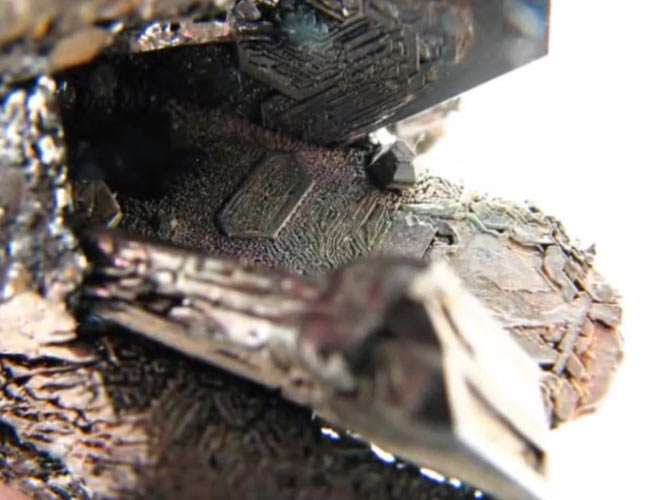 |
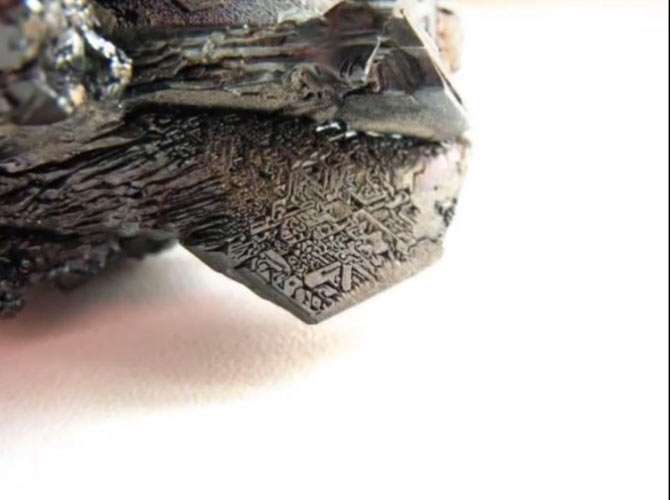 |
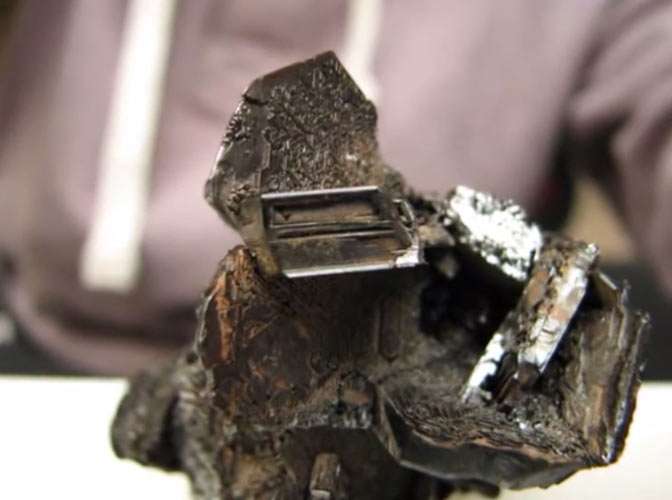 |
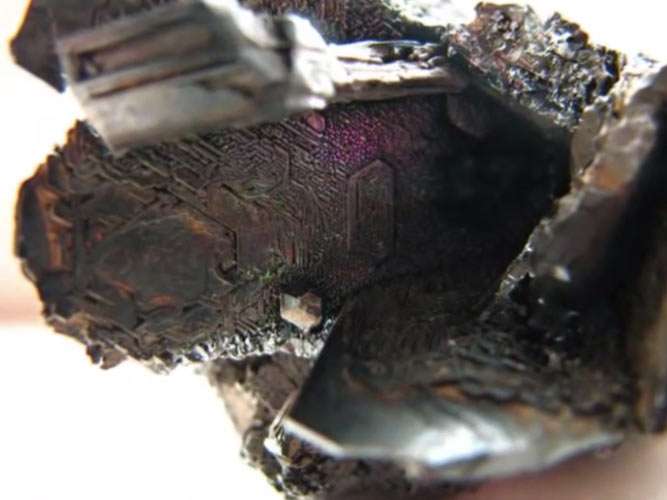 |
One of the areas where stones were arranged in
a circle.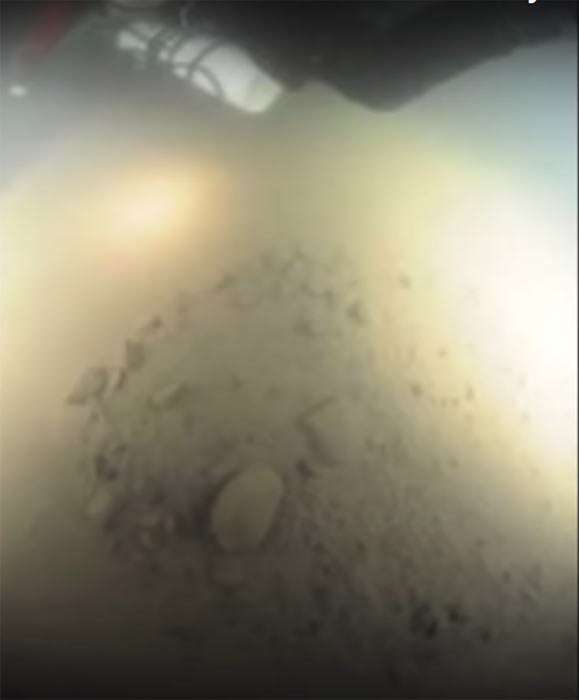 |
A stone 'ring' on top of the structure.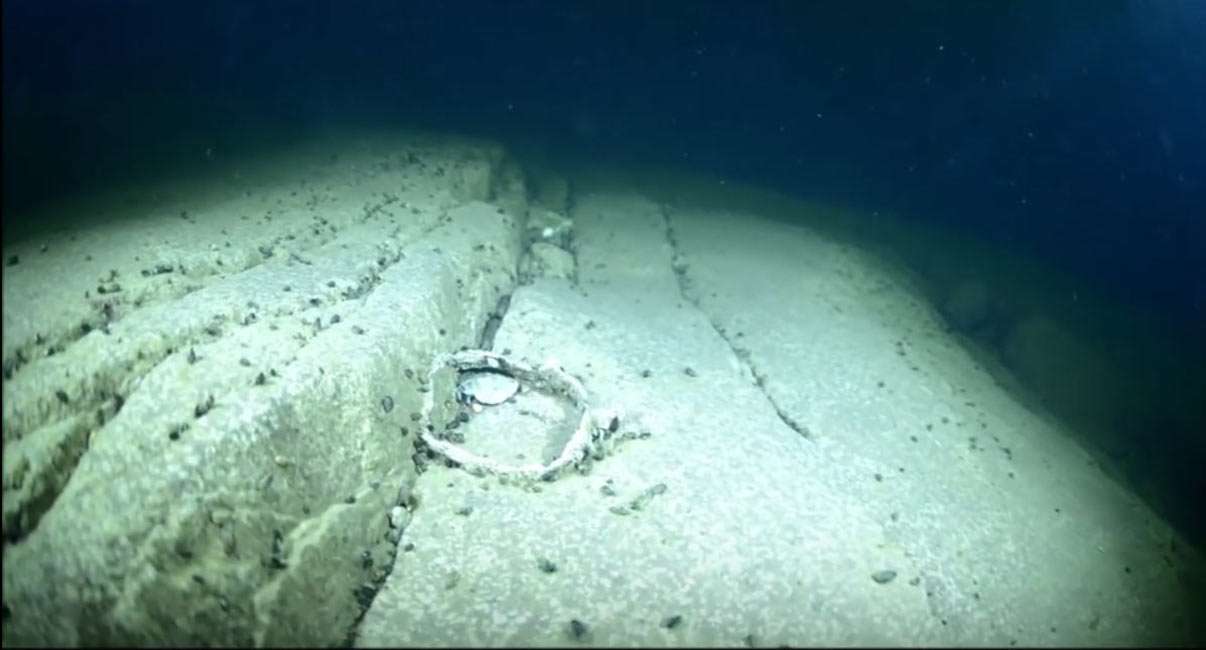 |
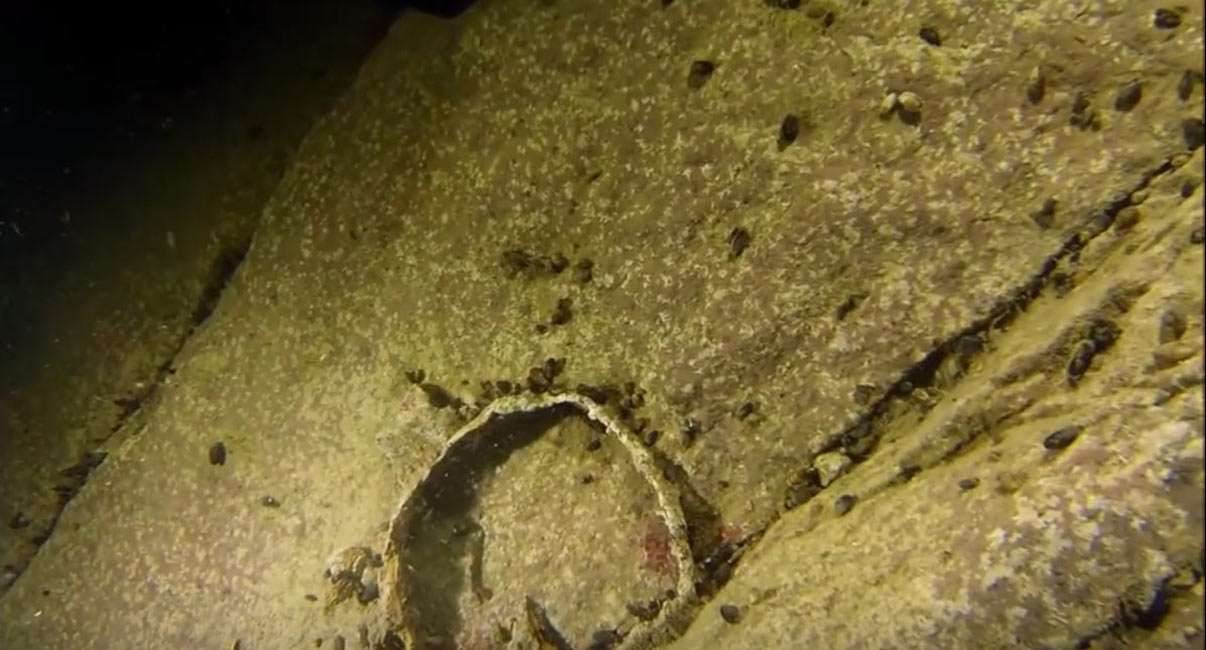 |
|
The 3-D sonar scans were able to look inside the structure and revealed smooth walls and straight corridors. OXT only hints at what this might imply: a complex building. One of the geologist, who was shown the sonar scans, remarked (in one of their videos) that the edge of one corridor was showing a much harder material, probably metal. The walls inside the structure are perfectly straight and at right-angles to the floor. The walls also have 90 degree angles. Dennis Åsberg said: "When we went out and saw the walls which were straight and smooth, it was frightening, as in a science-fiction film". He probably meant the walls on the outside of the building. Dennis Åsberg cannot claim that it is a building as their data are limited. However he has hinted at it several times, and everything points to a man-made building that must be very ancient, because at one time it was built on dry land, and it has been a very long time when the Baltic Sea was dry. Peter Lindberg: "The images has previously shown defined 90 degree angles. Many 90 degree angles and straight lines: .5 – 1.5 meter ( 1.5 to high 5 feet) corridors within object. They appear to be like passages or walls approx. 1.5 meters in height and 3 meters (10 feet) wide, which are cut into the object. The walls are straight and smooth. The walls are made of stone resembling sandstone." |
This are two of the radar
scans showing vertical straight corridors with 90 degree angles
inside the structure, that means underneath the roof. At the top
of the picture, the bright edge of the corridor shows a material harder
than stone, and is probably metal according to the geologist mentioned above.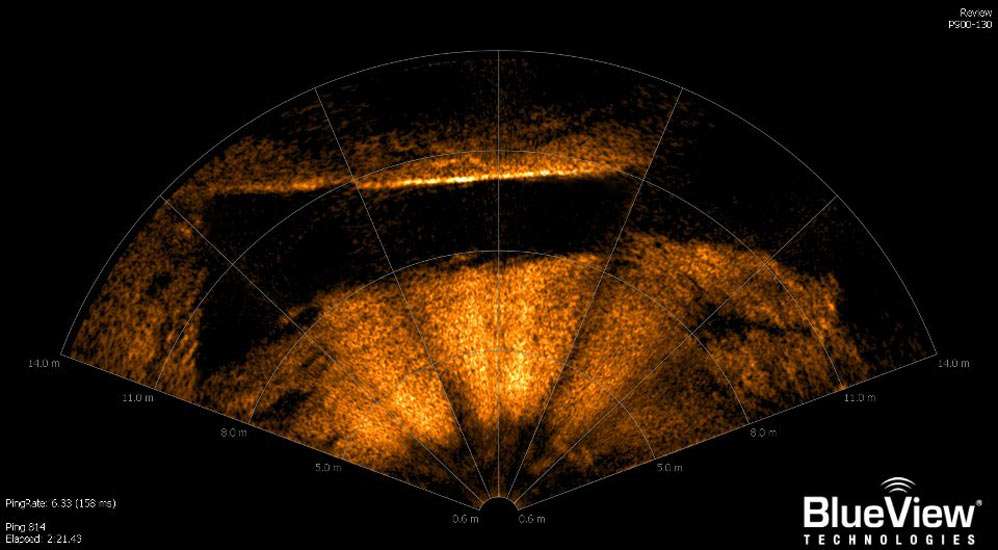 |
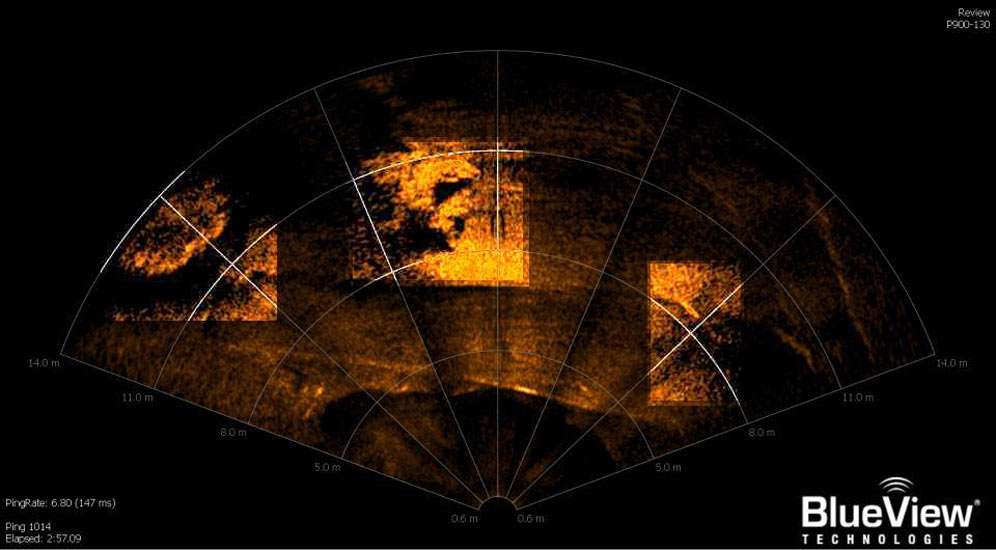 more scans on Ocean Explorer Facebook |
|
On October 4th, 2014, OXT posted the following picture on their website with the following comment: "Picture
of the object in the Baltic
Sea, Question nobody is asking: if this is in one of the corridors, did the ROV go inside the building? What else did it film inside? This picture is only one still image from a video the ROV made.
|
|
On top of the upper structure, which is basically the roof of the building, the divers found two holes. The smallest one is 25-30 cm (1 foot) in diameter and goes straight into the object. The other hole is about two meters (6 1/2 foot) across. This one has a square frame around it, and it also goes straight into the object. You can clearly see it in the radar scan below. Question: what purpose did the holes have, venting? |
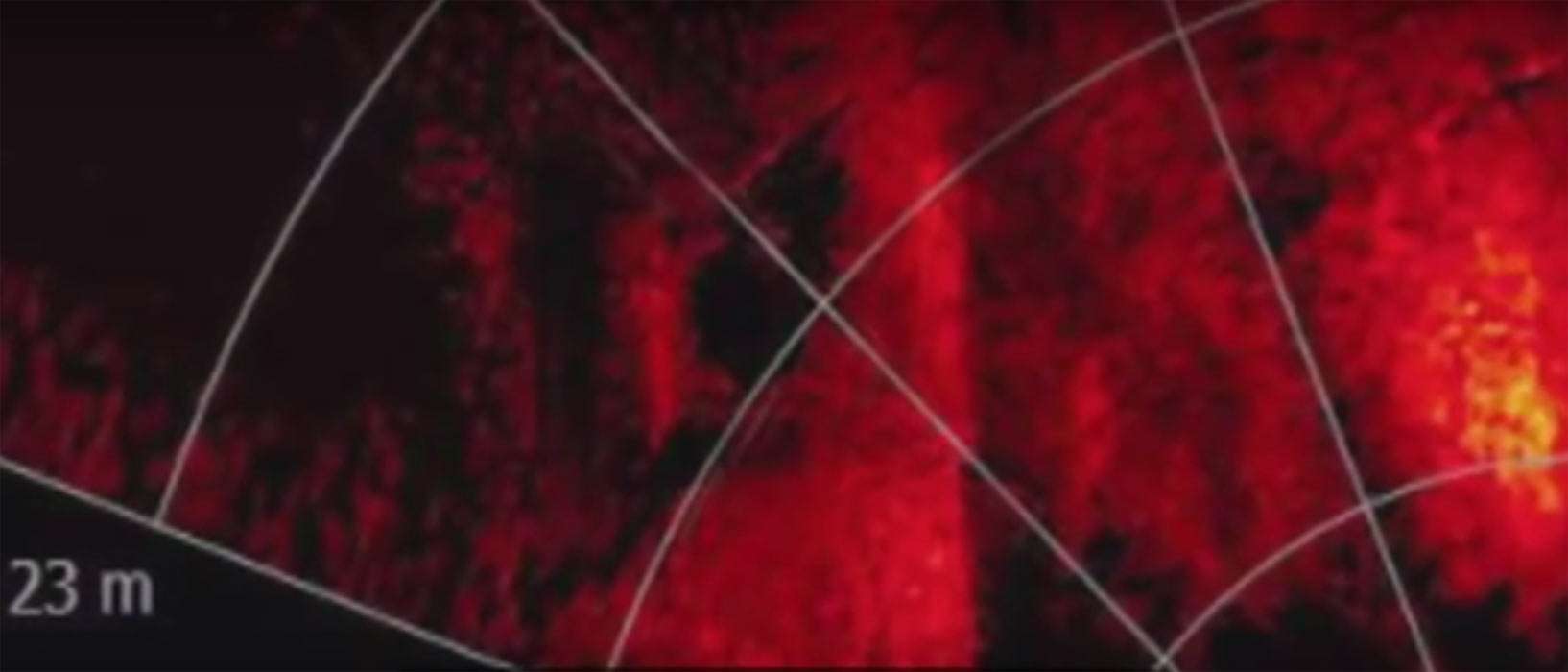
|
"We have not been able to find more holes besides the 2 meter hole with a square around it … and a smaller 25 centimeters wide. We did not find back to that hole. It seemed like dust or something came out of it and we got a little scared and did not want to loose the ROV." This would suggest that something in the building is still working, and is venting something through the holes. |
|
On the roof of the building the divers also found a smoothly shaped dome. This following image shows this dome shaped piece that has an estimated width of 10 feet (3 meters), a length of 32 feet (10 meters), and a height of 15 feet (1.5 meters). from https://www.gofundme.com/oceanxteam |
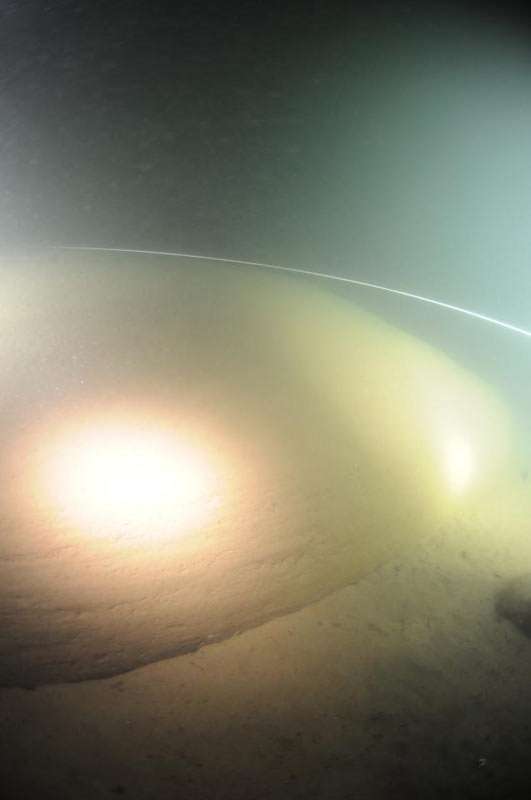
|
At one side of the object is something that looks like a staircase, in the southwest corner. Each of the steps has the same dimensions. There are eight steps. Each one has a one meter (3 feet) drop. Thus they are not real stairs. Below, on the left, is an enhanced picture. North is at the top. The stairs are in the lower left (the southwest corner). The picture on the right is an artist's rendering. |
|
|
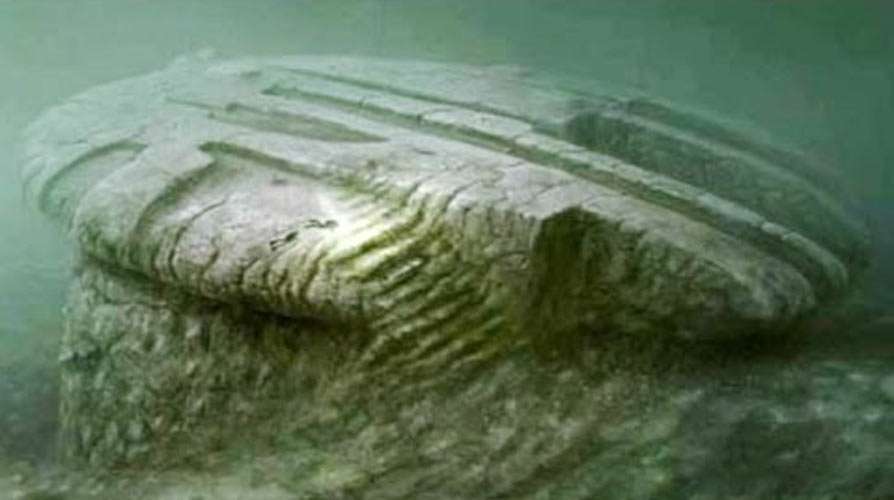 |
|
During the dive, some rocks were gathered from the top of the structure for further analysis. Information on the web about the rocks and the results of their analysis is a bit scattered and confusing. It only provides us with a general idea about the nature of the rocks itself. Where they came from is another question. One would think that having been under water for many millennia, any rock on the roof of the building would have been swept away by the ocean currents in the past, as at present the water is absolutely still at that depth. There is also the mystery why some of the rocks are placed in circles. |
|
Rocks in circular formation: 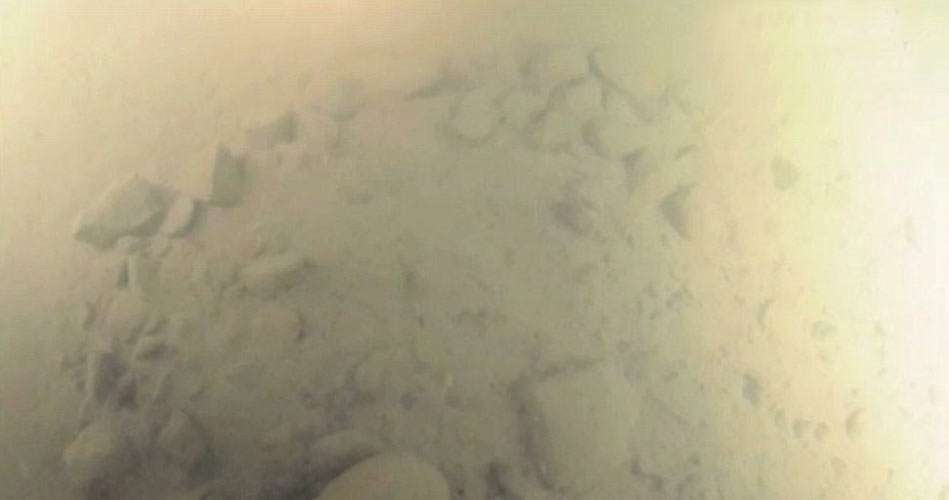 |
Another picture of rocks on the roof 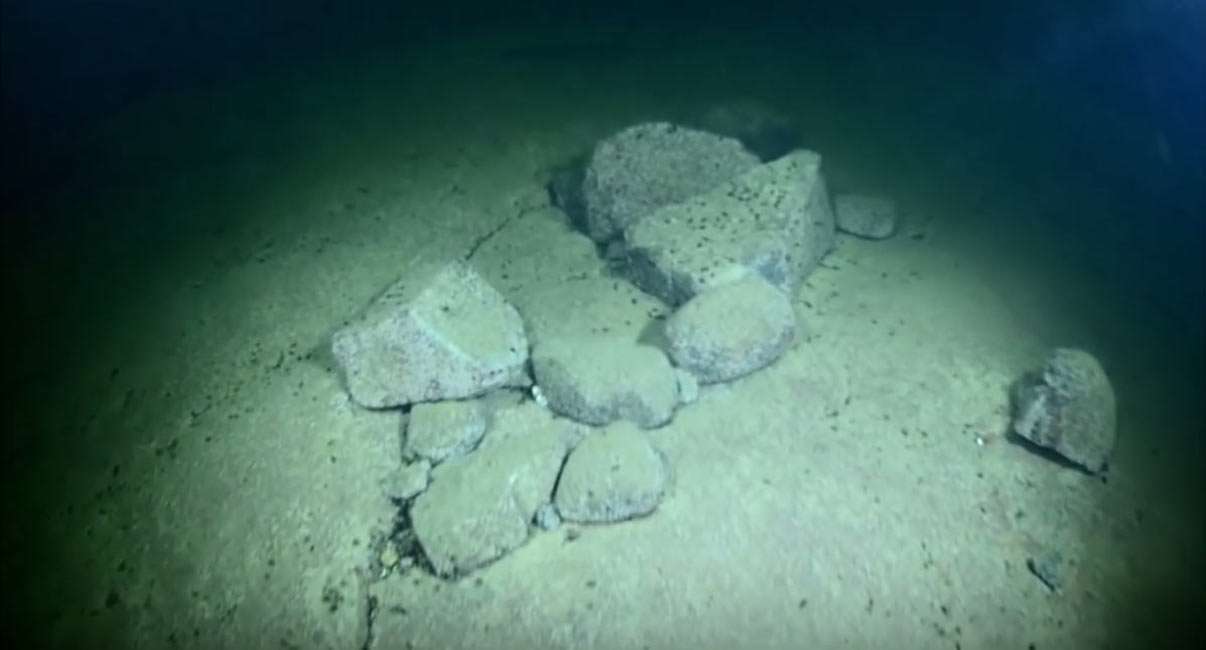 |
|
During the expedition of 2012 the team managed to
return with two samples from the anomaly. It is very strange to have a basalt rock lying on the structure, because the Baltic Sea does not have any volcanic activity. And again, here we got some proof that something got burned. |
|
The basalt rock: 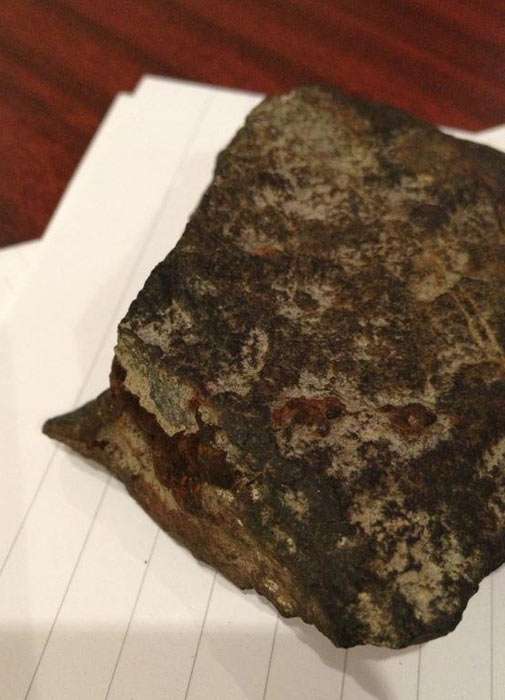
 |
|
The second sample was removed from a piece of the
'anomaly' itself. |
|
Other sources say that the rock samples were send to different laboratories. On the oceanexplorer.se website is report of another study done by The Geological Survey of Israel department from the Ministry of Energy and Water Resources in Israel, which analyzed three samples directly from a crack in the top surface, one basalt rock, and sediment also from the top. In their report (September 2013) they concluded that the rocks (except for the basalt rock) were Aluminum-silicate rocks with very high concentrations of iron and manganese. In one sample, the sediment had a very high amount of titanium in it.
These tests, although limited in their scope, are interesting and indicate that we are dealing with an artificial structure or some mining activities. |
|
Pictures below: rock samples gathered from the top of the object. They have a burned looking appearance, and are iron based. The third picture shows a smooth, reflective surface. They could be pieces from iron ore mining, or the (by)product of processing iron ore. |
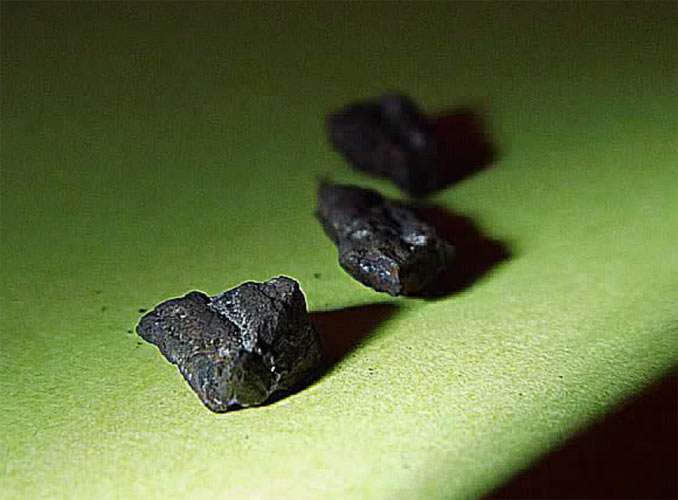 |
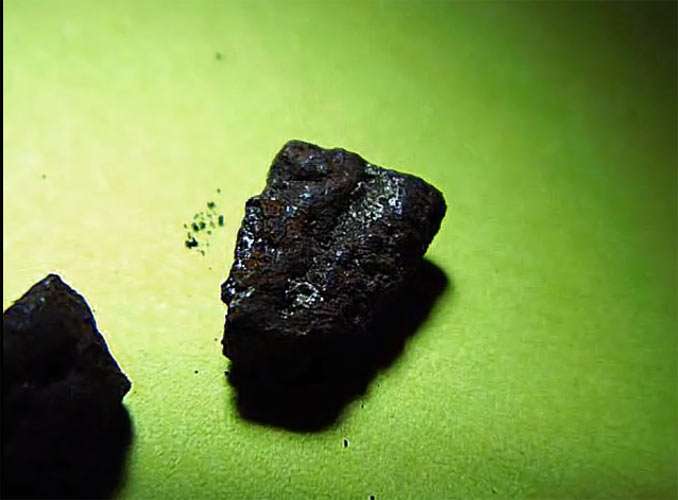 |
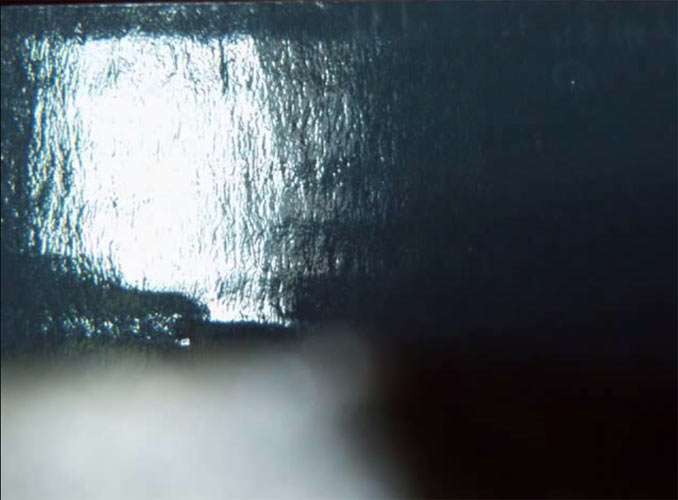 |
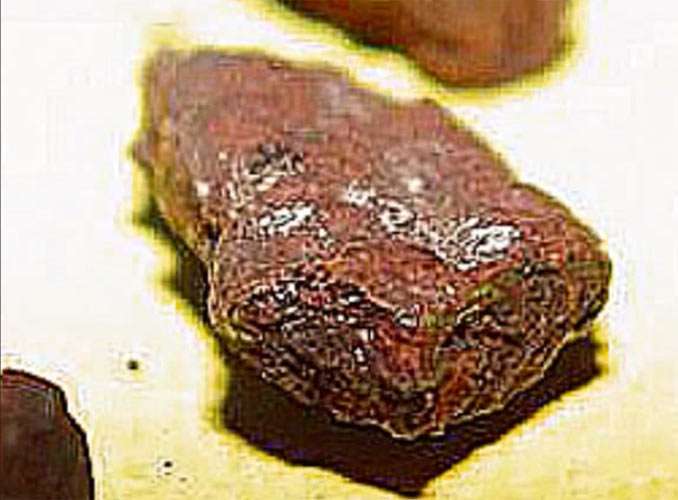 |
|
When OXT went back in 2012 they found that their sonar images also showed a long trench going from the object to a elevated 'mountain' feature some distance away. Originally they thought that that they were possibly dealing with a crashed flying saucer that had scooped out a long path in the soil and had come to a stop where it is resting now. The trench is 545-metre (1800 feet) long, and has a kind of vertical wall on one side. The Baltic Sea at that depth is completely still. There are no water currents that could have been responsible for creating troughs or dunes, or sand bars, on the sandy sea floor. So it is not a natural feature. In case the anomaly is a structure or building, then the trench probably is an artificial landscaping for whatever reason. |
|
The following picture was taking with Multibeam sonar. The color range shows depth and creates a top-side view of the seafloor. Warm colors (red, orange, yellow) correspond to shallower water depths, while cooler colors (green, blue, purple) indicate deeper depths. (Source: DiscloseTV, but I think it was originally on http://www.gofundme.com/oceanxteam . The 'anomaly' is at the left. At the right is the 'mountain' that appears to have been dented in the middle. In between is a straight rack scooped out of the sea bottom.
|
Close-up of the 'mountain'. It looks like it has
been cut in two. 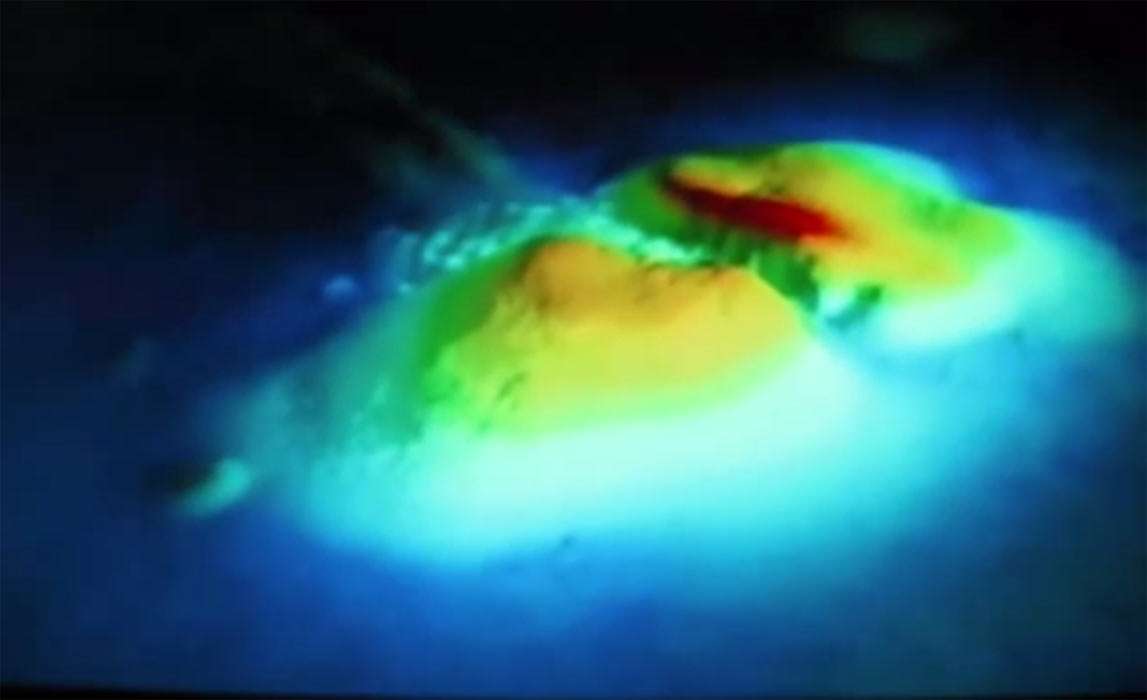 |
A 3-D rendering of the gouge. It does not look
natural. To me it looks like this was cut out this way intentionally.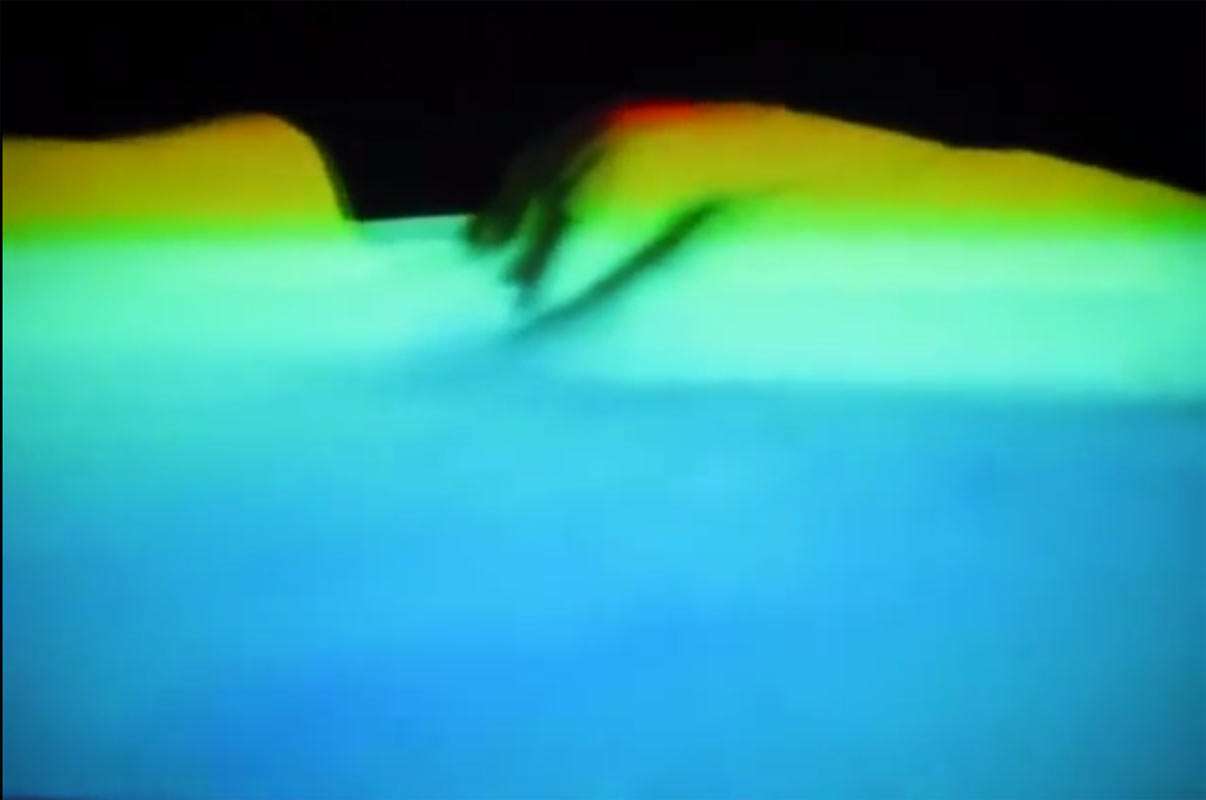 |
|
The radar scans from 2012 also showed a second strange anomaly not far away. This one is not circular but is also elevated from the sea floor. It is about 120 meters (400 feet) away from the large one. It also has a 'trail'. The trail is in the same direction and parallel with the other one. The team did not have enough time to examine this anomaly. |
|
The empty tracks in the middle of the image is because of the type of radar used. This radar will scan everything on the both sides in detail, but cannot scan anything directly underneath. The second anomaly might be another building. You can see the track underneath it. 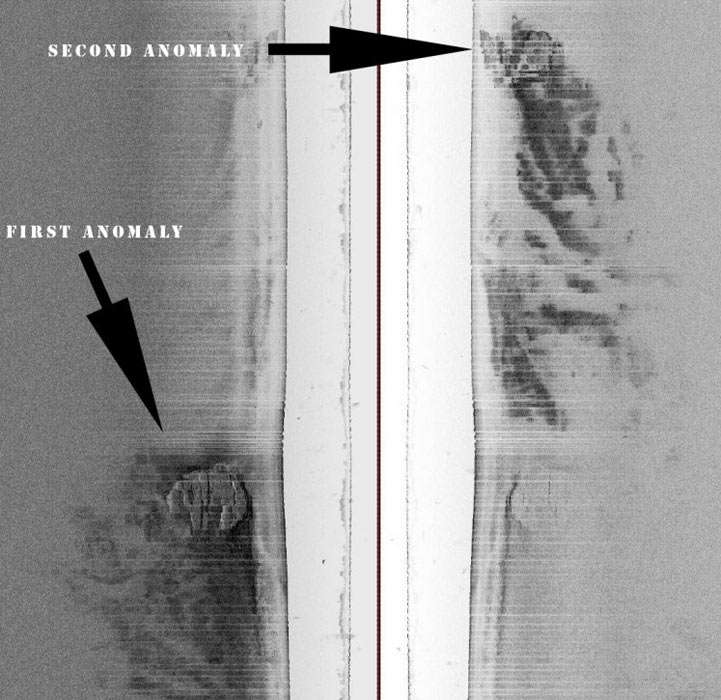 |
|
In 2014 the OXT made another radar scan of the two objects wit new sonar equipment. Below picture is from Ocean Explorer Facebook site, which has the August 2014 Sonar Scans of A2 (Anomaly 2). |
|
|
|
I mentioned before that on their way to the anomaly, on their second trip in 2012, a Swedish Navy ship showed up and came very close to the OXT vessel. It is safe to assume that the military would not like civilians to investigate something that is associated with remains of advanced technological civilizations. If the Baltic Sea monument has advanced technology still in it, and maybe some of it is still working, then the military will do their best to keep it out of the hands of ordinary people. In this regard it is not strange at all, although it was for the unsuspecting OXT, that all their electrical equipment was experiencing repeated interference to the point that some of it quit working. The military is well equipped to interfere with any electrical device, from a distance by sending out the appropriate electromagnetic frequencies or wave forms. So it happened to the members of the OXT as soon as they arrived at the anomaly. When they came within 100 meters (30 feet) of the object, they started to experience problems with the satellite phone. Then they had problems with the underwater camera, and the ROV robot sonar equipment. Also a video camera had problems. Dennis did not pay too much attention to it, as with every dive there are always problems. Peter Lindberg: "Another thing is that we could not use the satellite phone when we where laying above the circle, but just some tenth of meters off position the phone worked. I do not know why but it is a fact. Furthermore, the video camera’s lights blew when the diver started them up on the surface when testing them before dive # 2. They decided anyway to bring the video camera with them and try to use their ordinary lights to illuminate for the video. When they descended the video camera started to showing an “error” message on the small monitor. The diver restarted the camera several times and finally it seamed to work. So he filmed their dive but nothing was on the tape when watching it afterwards. The only problem we had with the ROV was that we constantly had to restart the sonar. Finally it did not work and we continued with just the video camera. When we left the circle we went to a wreck and spent like 35 hour of ROV flying on the wreck and the sonar worked all the time. Magnetic disturbances, well you tell me!”
The External Radio Signal
However, in a TV interview (Swedish TV4) they mentioned that they had picked up a radio signal, but did not comment any further on it but that they wanted to investigate it further. It turned out that the signal did not come from the anomalous object, but from somewhere else. "Normally radio communication from submarine vessels is using the frequency band below 200 kHz, so the signal in the band 40-50 MHz is probably not coming from a submarine unit. The frequency band is used by Russia for vessel tracing and localization." This is based on notes found in WARC documents. (WARC is the global organization for frequency coordination: World Radiocommunication Conference). "We brought a specialist understanding the signal that we picked and it came from the Russian Navy .. we know that we have this signal, but not what it meant. Its data we collected. Maybe its a ‘sound’, but we didn’t hear it." Source: disclose.tv The OXT had already been suspecting that it might have come from military vessel. After all there were five large military ships lurking in the neighborhood. In the months afterwards, OXT did make some veiled statements that the military are very aware of their activities, and that they had examined the OXT data,... and that the military was very much involved in it. Dennis Åsberg: "Yes the Swedish Navy is very interested to know more about the Baltic object. They’ve been informed with all data. When we were out there we had like 6 big NATO ships not far away. A Swedish navy ship came up asking what we were doing. The military is involved in the project, yes! We have spoken to the highest officers in the military. So why are they interested? Believe me, its more than a stone. We can’t tell you everything yet about that part." Source: Q&A session Dennis Asberg |
|
"Someone asked about what temperature we had down there. Well the divers' thermometer showed -1° C (31° F) when they were on top of the circle, it should be +4° C (40° F). The thermometer may have showing a wrong value of course.” Stefan Hogeborn, Professional Diver Normally at depths of 40 meter and below the water temperature is about 4 degree Celsius, and this is all year. At that depth it does not vary. Only at the very surface of the ocean does the temperature change with the seasons. When they went down at the anomaly object, they measured -1 C (31° F) at 40 meters deep and 2° degrees (35° F) when they reached the bottom. This was on every dive. So something is going on at that location that is changing the temperature of the water. The OXT does not have an explanation for this. |
|
"Incredible, we have measured the radioactive value of the anchors we used. It’s quite intriguing, the normal level of radiation is 0,1 milli Sieverts and we get 0,63 when measuring on the anchors. It’s far from dangerous levels but still; it’s 6 times higher than a normal level of radiation. The anchors have been on the bottom like 2-3 kilometers from the circle, so one can wonder if we will get higher values of radiation the closer we get of the circle?" posted on April 2, 2012 by OXT When they measured the radioactivity of cameras and other equipment they used, the radiation was measured to 0.3 millisieverts. Source: norrteljetidning.se This adds another level to the idea that this building might have been a mining facility, and maybe also a processing facility for certain metals, some of which might have been radioactive elements. |
|
The Ancient Origin of the Building It looks like the 'anomaly' is actually an artificial construction, a building of some sorts, and thus man-made. This means that it must be older than 12,000 years ago, when the seafloor of the Baltic Sea was dry land. The last glacial period, popularly known as the Ice Age, was the most recent glacial period within the Quaternary glaciation occurring during the last 100,000 years of the Pleistocene, from approximately 110,000 to 12,000 years ago. During this last Ice Age, sea level was at least 394 feet (120 m) lower than it is today. As the object, or building, presently is at 275 feet (83 meters) deep, this means that it was on dry land at least 12,000 years ago. Of course, it can be much older than that. |
|
Remote viewing can be seen as a kind of clairvoyance. If you don't know what it is, you can go here for an explanation. The remote viewer himself is always 'blind'. That means that he never knows what the target is. The information that is obtained by remote viewers will differ from one to another, because the person is only recording what he is perceiving through his mind, and someone's mind is different than that from another person. OXT discovered the Baltic Sea Anomaly on June 19, 2011. At that point they did not know what they had discovered. All they had were radar images. There were several theories, but the radar scans could not provide much information as to its identity. In August 2011, a company called Transception hired some remote viewers to look into this target. The information thus obtained was very intriguing, and supports the data that was gathered by the OXT on their dive in 2012. (The present website of Transception is non-functional, but you can go the WayBack Machine for an archived version). Before It's News published the the remote viewers findings: TRANSCEPTION's preliminary analysis of the seven sessions specifically tasked against the Baltic Sea USO target (plus another one based on directly related tasking), suggests that the site is a complex of structures–a mining/production/resupply facility–among other things, centered around a special type of "lock" (described by the viewers as being “like” a “dam”, “barrier”, “missile silo”, and even Han Solo's “moon tube”), mechanically operated and comprising, at least in part, a cluster of densely packed, hydraulic levers that arc energetically back and forth, controlling the flow of a liquid (most likely water) used in the production of a much needed viscous, energetic, oil-like substance, dark in color and possibly toxic, with constituent and extremely valuable elements/materials mined locally. Situated immediately below the predominate structure is a gargantuan chamber and network of tubes and/or connecting shafts, all underground. The beings responsible for its existence wear a special face mask to protect them from the environment extant at the time of construction. For the lock to work, it requires a special "key", which is missing. 90% of the site is underground. There is most likely a "Mayan"/ET connection. One of the viewers insists vehemently that humanity is not ready for knowledge constituting the “key”, much less the technology constituting the site. The Ocean Explorer team should exercise caution when approaching the site, much less anchor immediately over it, in that several viewers mentioned that they felt a sense of danger at the site, in that a major perception at the site is that of intense energetics present at the site at one time or another. Multiple sites like this one are extant. There is YouTube video that shows a selection of the sessions with the remote viewers. What keeps coming up is the heat that comes up through tubes. Interesting in relation to the holes the OXT found at the top of the structure, that out of one of them some dust was blowing up, and that the rocks they gathered were burned. On his website Edward Riordan, one of the remote viewers, summarizes his own findings: "On August 11, 2011, I was contracted by Austin-based R&D company Transception Inc. to perform a remote viewing session. During the session, I perceived an object that was round, large, metallic, and very old but newly discovered. It reminded me of a UFO. The object had vent shafts that were emitting heat." If we compare these findings with what the data that OXT has gathered from their second dive, then we find some striking similarities. In the above description is an interesting remark: "The beings responsible for its existence wear a special face mask to protect them from the environment extant at the time of construction." First, the remote viewer did not say 'humans' but 'beings', and that they were wearing a special face mask. That reminded me of another remote viewer, Dick Allgire, from the Farsight Institute, who remote viewed the construction of the Great Pyramid of Giza, Egypt. He also described facemask certain (alien) beings were wearing when mining underground. In my opinion, the mining activities and the beings once involved at the mining facility of the 'Baltic Sea Anomaly' might be very similar to Dick Allgire was describing in relation to the mining activity for the construction of the Great Pyramid. Here is a summary from that session, which you can see in its entirety at YouTube. Allgire's description starts at about 38 minutes into the video. The mining of the largest rocks used in the construction of the Great Pyramid of Giza involves rocks being crushed, cut, and pulverized with great force, apparently creating sheer cliffs. Great energy was apparently involved in this process, producing gaseous and shock-wave by-products. Great energy is used in the process, involving the melting of rock. There is mining on a large scale. Energy is used to cut rock much in the manner that welding is done with metal, producing liquefied rock. It is "high tech alien mining". They use energy tools that focus energy on rock. The rock is both liquefied and vaporized, involving great heat and pressure, thereby separating the rock. There are life forms working on all of this. They have a hive mentality, working in large numbers underground. They feel like "drones, and are not too smart". These are drone-like humanoids who are genetically engineered to work under extremely harsh and polluting environments, involving high tech processes used for constructing large rock structures. The environment is like a foundry with toxic air quality. They are used in mining, in large underground tunnel complexes and caves. In these underground caverns rocks are melted, and the air quality is extremely toxic. Therefore these drones are wearing special face masks. These masks are very thin and made with nano-technology. They fits precisely over the face, they kind of 'form-fit' to the face, and provide a certain filtration and eye protection. However the drones do not last long in these environments. They eventually deteriorate and cease to function. The drone workers are "grown" from fetuses in artificial environments by beings who look like "preying mantis". The preying mantis are in charge of the drones, and although they care about the health of the drones, the drones themselves are considered as easily replaceable. When one is worn out, they just grow another one. |
|
|